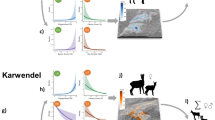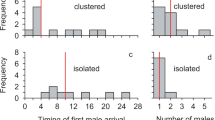Abstract
The spatial organization of individuals in populations (their spacing system) can be highly variable even among populations of the same species1. As spacing systems have important consequences for ecological processes such as population regulation, competition and mating systems2,3, there have been many attempts to explore factors that may cause this variation. For mammals, it has been argued that the spatial distribution of sexually receptive females is the most important factor determining the spacing system of males, whereas habitat characteristics are most important to females4–6. This has been difficult to test experimentally as it requires manipulations of the spatial distribution of the opposite sex without changing other properties of the environment7. Here, I present a novel experimental procedure that can achieve this and demonstrate that the spatial distribution of the opposite sex in a population of voles is indeed an important determinant of the spacing system of males, but not of females. However, the effects on males are different from those predicted by many theoretical studies.
This is a preview of subscription content, access via your institution
Access options
Subscribe to this journal
Receive 51 print issues and online access
$199.00 per year
only $3.90 per issue
Buy this article
- Purchase on Springer Link
- Instant access to full article PDF
Prices may be subject to local taxes which are calculated during checkout
Similar content being viewed by others
References
Lott, D. F. Behaviour 88, 266–325 (1984).
Brown, J. L. & Orians, G. H. A. Rev. Ecol. Syst. 1, 239–262 (1970).
Carpenter, F. L. Am. Zool. 27, 223–228 (1987).
Wittenberger, J. F. Animal Social Behaviour (Duxbury, Princeton, 1981).
Eisenberg, J. F. The Mammalian Radiation (University of Chicago Press, Chicago, 1981).
Ostfeld, R. S. Am. Nat. 126, 1–15 (1985).
Ostfeld, R. S. Oikos 48, 238–240 (1987).
Ims, R. A. Ecology (in the press).
Davies, N. B. & Houston, A. I. in Behavioural Ecology: An Evolutionary Approach (eds Krebs J. R. & Davies, N. B.) 148–169 (Blackwell Scientific, Oxford, 1984).
Carpenter, F. L. Am. Zool. 27, 387–397 (1987).
Hixon, M. A. Am. Zool. 27, 229–247 (1987).
Emlen, S. T. & Oring, L. W. Science 197, 215–223 (1977).
Ims, R. A. J. Anim. Ecol. 56, 585–596 (1987).
Ostfeld, R. J. Anim. Ecol. 55, 691–706 (1986).
Williams, G. C. Am. Nat. 100, 687–690 (1966).
Trivers, R. L. in Sexual Selection and the Descent of Man (ed. Cambell, B.) 136–179 (Aldine, Chicago, 1972).
Ims, R. A. Am. Nat. 130, 475–484 (1987).
Parker, G. A. in Behavioural Ecology: An Evolutionary Approach (eds Krebs, J. R. & Davies, N. B.) 30–61 (Blackwell Scientific, Oxford, 1978).
Schwagmeyer, P. L. & Woontner, S. J. Behav. Ecol. Sociobiol. 17, 291–296 (1985).
Kaufman, J. J. Biol. Rev. 58, 1–20 (1983).
Klecka, W. R. SPSS: Statistical Package for Social Sciences (eds Nie, N. H. et al.) 434–468 (McGraw-Hill, New York, 1975).
MacFarlane, J. D. & Taylor, J. M. J. Mammal 63, 104–109 (1982).
Kawata, M. Oikos 45, 181–190 (1985).
Author information
Authors and Affiliations
Rights and permissions
About this article
Cite this article
Ims, R. Spatial clumping of sexually receptive females induces space sharing among male voles. Nature 335, 541–543 (1988). https://doi.org/10.1038/335541a0
Received:
Accepted:
Issue Date:
DOI: https://doi.org/10.1038/335541a0
This article is cited by
-
Should I stay or should I go now: dispersal decisions and reproductive success in male white-faced capuchins (Cebus imitator)
Behavioral Ecology and Sociobiology (2022)
-
Untangling the influence of biotic and abiotic factors on habitat selection by a tropical rodent
Scientific Reports (2021)
-
Phase- and season-dependent changes in social behaviour in cyclic vole populations
BMC Ecology (2019)
-
Effects of human-made resource hotspots on seasonal spatial strategies by a desert pitviper
Scientific Reports (2019)
-
Food supplementation affects the foraging ecology of a low-energy, ambush-foraging snake
Behavioral Ecology and Sociobiology (2017)
Comments
By submitting a comment you agree to abide by our Terms and Community Guidelines. If you find something abusive or that does not comply with our terms or guidelines please flag it as inappropriate.



